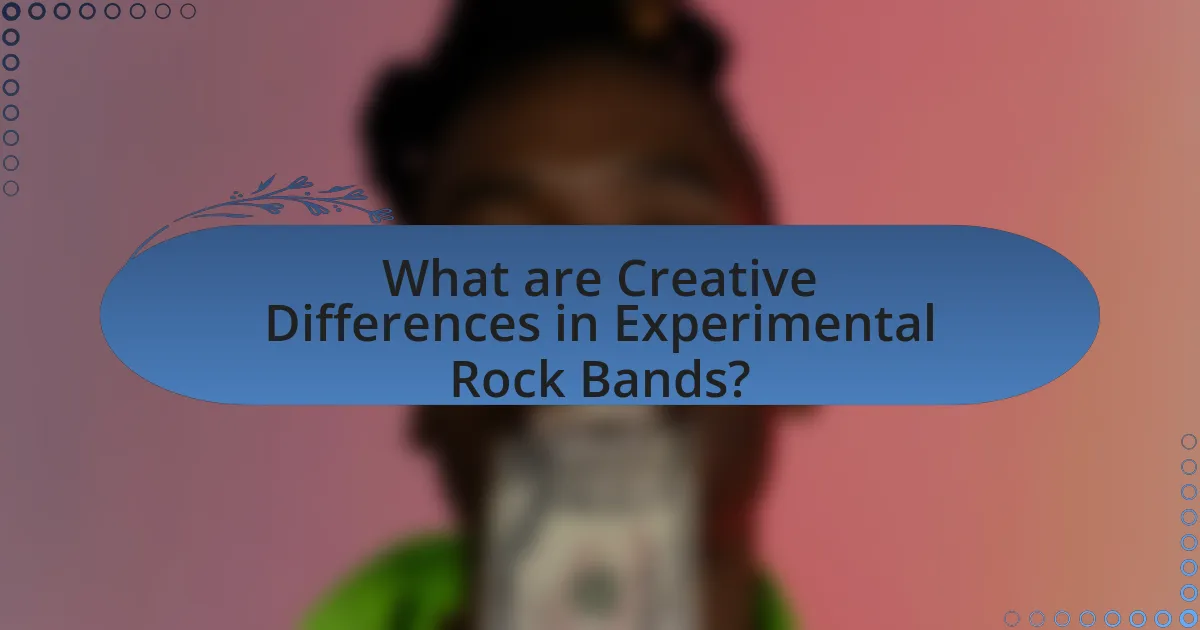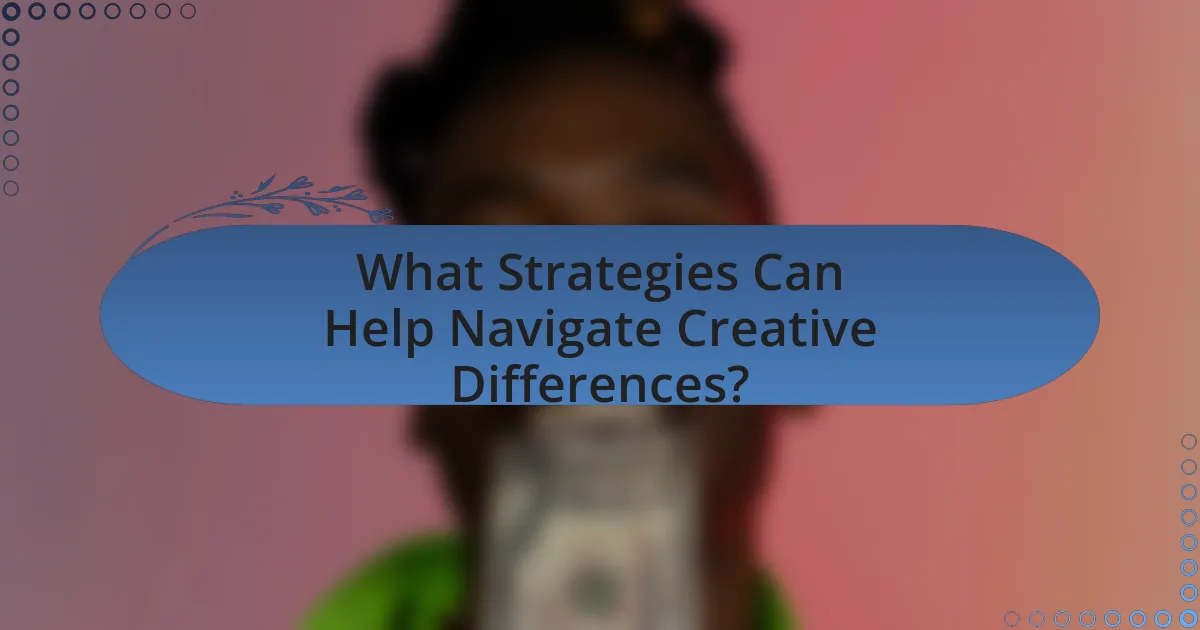The article focuses on navigating creative differences within experimental rock bands, highlighting the conflicts that arise from varying artistic visions, musical preferences, and conceptual approaches among members. It explores how these differences can manifest during collaboration, the common sources of conflict, and the importance of individual artistic visions in shaping a band’s identity. The article also discusses strategies for effective communication, compromise, and collaboration, emphasizing their role in fostering innovation and enhancing the creative process. Practical tips for maintaining harmony and preventing misunderstandings are provided, along with guidelines for establishing a productive collaborative environment.

What are Creative Differences in Experimental Rock Bands?
Creative differences in experimental rock bands refer to the varying artistic visions, musical preferences, and conceptual approaches among band members that can lead to conflicts or disagreements. These differences often arise due to the genre’s emphasis on innovation and personal expression, which can result in divergent ideas about song structure, instrumentation, and overall sound. For instance, bands like Radiohead and The Mars Volta have experienced notable creative tensions, where individual members’ desires for experimentation and direction have shaped their music but also led to internal disputes. Such creative differences can ultimately influence the band’s dynamics, collaboration processes, and the final output of their work.
How do creative differences manifest within a band?
Creative differences within a band manifest primarily through conflicting artistic visions, disagreements over musical direction, and varying levels of commitment to specific projects. These differences can lead to tension during songwriting sessions, where members may struggle to agree on arrangements, lyrics, or overall sound. For instance, a guitarist may prefer a heavier sound while a vocalist might advocate for a more melodic approach, resulting in friction that can hinder collaboration. Historical examples include bands like Fleetwood Mac, where personal relationships and differing creative priorities led to both conflict and innovative music, illustrating how such differences can shape a band’s identity and output.
What are common sources of conflict among band members?
Common sources of conflict among band members include creative differences, financial disputes, and personality clashes. Creative differences often arise when members have varying visions for the music or artistic direction, leading to disagreements on song composition and performance style. Financial disputes can occur over revenue sharing, expenses, and management decisions, which can create tension if not addressed transparently. Additionally, personality clashes may emerge from differing work ethics, communication styles, or personal values, causing friction within the group dynamic. These conflicts can hinder collaboration and affect the overall success of the band.
How do individual artistic visions contribute to creative differences?
Individual artistic visions contribute to creative differences by introducing unique perspectives and interpretations that shape the overall direction of a project. Each artist brings their own experiences, influences, and preferences, which can lead to varying ideas about sound, style, and thematic content. For instance, a study published in the Journal of Creative Behavior highlights that collaboration among artists with distinct visions often results in innovative outcomes, but can also create tension when those visions clash. This dynamic illustrates how individual creativity can both enrich and complicate the collaborative process in experimental rock bands.
Why are creative differences important in the creative process?
Creative differences are important in the creative process because they foster innovation and enhance the quality of the final product. When individuals bring diverse perspectives, ideas, and experiences to a project, they challenge each other’s assumptions and push boundaries, leading to more original and compelling outcomes. Research indicates that teams with varied viewpoints are more likely to generate creative solutions, as evidenced by a study published in the Journal of Creative Behavior, which found that diverse teams outperform homogeneous ones in problem-solving tasks. This dynamic not only enriches the creative process but also encourages collaboration and personal growth among team members.
How can creative differences lead to innovation in music?
Creative differences can lead to innovation in music by fostering diverse perspectives that challenge conventional ideas. When musicians with varying backgrounds and styles collaborate, they often push each other to explore new genres, techniques, and sounds. For instance, the collaboration between David Bowie and Brian Eno in the late 1970s resulted in the groundbreaking “Berlin Trilogy,” which blended rock, electronic, and avant-garde influences, showcasing how differing artistic visions can create entirely new musical landscapes. This dynamic not only enhances creativity but also encourages experimentation, ultimately leading to the development of innovative music that resonates with broader audiences.
What role does collaboration play in resolving creative differences?
Collaboration plays a crucial role in resolving creative differences by fostering open communication and mutual understanding among band members. When musicians collaborate, they engage in discussions that allow them to express their individual ideas while also considering the perspectives of others, which can lead to innovative solutions. Research indicates that collaborative environments enhance creativity and problem-solving, as seen in studies like “The Role of Collaboration in Creative Problem Solving” by Paul Paulus and Bernard Nijstad, which highlights how diverse viewpoints contribute to more effective outcomes. This process not only helps in reconciling differing opinions but also strengthens the overall cohesion of the band, ultimately leading to a more unified creative vision.

What Strategies Can Help Navigate Creative Differences?
To navigate creative differences effectively, experimental rock bands can implement open communication, establish clear roles, and engage in collaborative decision-making. Open communication fosters an environment where all members feel comfortable expressing their ideas and concerns, which can lead to innovative solutions. Establishing clear roles helps to minimize conflicts by defining responsibilities and expectations, allowing each member to contribute their strengths without stepping on each other’s toes. Collaborative decision-making encourages input from all members, ensuring that diverse perspectives are considered, which can enhance creativity and cohesion within the group. These strategies are supported by research indicating that teams with strong communication and defined roles experience higher levels of creativity and satisfaction, ultimately leading to more successful collaborative outcomes.
How can communication improve collaboration among band members?
Effective communication enhances collaboration among band members by fostering a clear exchange of ideas and feedback. When band members communicate openly, they can articulate their creative visions, address conflicts, and make collective decisions more efficiently. Research indicates that bands with strong communication practices report higher levels of satisfaction and creativity, as members feel valued and understood. For instance, a study published in the Journal of Music Psychology found that bands that held regular discussions about their creative processes were more successful in producing cohesive and innovative music. This demonstrates that structured communication not only resolves misunderstandings but also strengthens the collaborative spirit essential for experimental rock bands.
What techniques can be used to facilitate open dialogue?
Techniques to facilitate open dialogue include active listening, open-ended questioning, and creating a safe environment for expression. Active listening involves fully concentrating on the speaker, which fosters understanding and respect. Open-ended questions encourage deeper responses and exploration of ideas, allowing participants to express their thoughts freely. Creating a safe environment involves establishing ground rules that promote respect and confidentiality, which can lead to more honest and open exchanges. These techniques are supported by communication studies that emphasize the importance of these practices in enhancing dialogue and collaboration among diverse groups.
How can active listening enhance understanding among members?
Active listening enhances understanding among members by fostering an environment of open communication and empathy. When individuals actively listen, they fully engage with the speaker, which allows them to grasp not only the content of the message but also the emotions and intentions behind it. This practice reduces misunderstandings and promotes clarity, as members feel valued and acknowledged. Research indicates that teams that employ active listening techniques experience improved collaboration and problem-solving abilities, leading to more effective creative outcomes. For instance, a study published in the Journal of Applied Psychology found that active listening significantly correlates with team performance and satisfaction, highlighting its critical role in enhancing interpersonal understanding.
What role does compromise play in resolving conflicts?
Compromise plays a crucial role in resolving conflicts by facilitating mutual agreement among parties with differing viewpoints. In the context of experimental rock bands, compromise allows members to blend their creative ideas, ensuring that all voices are heard while moving towards a common goal. Research indicates that effective compromise can lead to enhanced collaboration and innovation, as it encourages flexibility and understanding among team members. For instance, a study published in the Journal of Conflict Resolution highlights that groups that engage in compromise are more likely to achieve satisfactory outcomes and maintain positive relationships, which is essential for the long-term success of collaborative artistic endeavors.
How can band members identify areas for compromise?
Band members can identify areas for compromise by engaging in open communication and actively listening to each other’s perspectives. This process involves discussing individual preferences and priorities, which helps to reveal overlapping interests and potential concessions. Research indicates that effective communication fosters collaboration and understanding, allowing band members to negotiate solutions that satisfy multiple viewpoints. For instance, a study published in the Journal of Applied Psychology highlights that teams that prioritize dialogue and feedback are more successful in reaching consensus, demonstrating the importance of these strategies in creative collaborations.
What are the potential outcomes of successful compromise?
Successful compromise can lead to enhanced collaboration and innovation within experimental rock bands. When band members reach a compromise, they often experience improved relationships, fostering a more cohesive creative environment. This collaborative spirit can result in unique musical experimentation, as diverse ideas are integrated into the final product. Additionally, successful compromise can increase overall satisfaction among members, reducing conflicts and promoting a more positive group dynamic. Research indicates that teams that effectively manage creative differences tend to produce higher-quality work, as seen in studies on group creativity and performance in collaborative settings.

What Are Some Practical Tips for Experimental Rock Bands?
Experimental rock bands should prioritize open communication and collaboration to navigate creative differences effectively. Establishing a regular practice schedule encourages consistent interaction and idea sharing, which fosters a collaborative environment. Additionally, setting clear roles within the band can help streamline the creative process, allowing each member to contribute their strengths while minimizing conflicts. Utilizing tools like recording software for demos can facilitate feedback and experimentation, enabling members to explore diverse sounds without the pressure of live performance. Research indicates that bands with defined roles and open communication tend to have higher satisfaction and productivity, as seen in studies on group dynamics in musical ensembles.
How can bands establish a creative framework to manage differences?
Bands can establish a creative framework to manage differences by implementing structured communication practices and collaborative decision-making processes. This approach allows members to express their ideas and concerns openly, fostering an environment of mutual respect. Research indicates that bands that engage in regular meetings to discuss creative direction and individual contributions tend to have higher satisfaction and productivity levels. For instance, a study published in the Journal of Music Psychology found that bands with clear roles and responsibilities experienced fewer conflicts and enhanced creativity. By prioritizing transparency and inclusivity, bands can effectively navigate their differences and harness diverse perspectives for innovative outcomes.
What guidelines can be set to ensure productive collaboration?
To ensure productive collaboration among experimental rock bands, establish clear communication protocols. Clear communication fosters understanding and minimizes misunderstandings, which is crucial in a creative environment. Additionally, set defined roles and responsibilities for each member to streamline decision-making and accountability. Research indicates that teams with well-defined roles are 30% more effective in achieving their goals. Regular feedback sessions can also enhance collaboration by allowing members to express their thoughts and concerns openly, leading to improved group dynamics. Implementing these guidelines can significantly enhance the collaborative process within experimental rock bands.
How can regular check-ins help maintain harmony in the band?
Regular check-ins can help maintain harmony in the band by fostering open communication and addressing issues before they escalate. These scheduled discussions allow band members to express their thoughts, feelings, and concerns, which can lead to a better understanding of each other’s perspectives. Research indicates that teams with regular communication are more cohesive and productive, as they can collaboratively resolve conflicts and align their creative visions. For example, a study published in the Journal of Applied Psychology found that effective communication significantly enhances team performance and satisfaction, which is crucial for maintaining harmony in a creative environment like a band.
What are some common pitfalls to avoid when navigating creative differences?
Common pitfalls to avoid when navigating creative differences include failing to communicate openly, allowing personal conflicts to overshadow artistic discussions, and not establishing clear roles within the group. Open communication is essential; research shows that teams with transparent dialogue are 25% more effective in resolving conflicts. Personal conflicts can derail creative processes, as evidenced by studies indicating that unresolved interpersonal issues can lead to a 50% decrease in team productivity. Additionally, clearly defined roles help prevent misunderstandings and ensure that each member’s contributions are valued, which is crucial for maintaining a collaborative environment.
How can bands prevent misunderstandings from escalating into conflicts?
Bands can prevent misunderstandings from escalating into conflicts by establishing clear communication protocols. Effective communication ensures that all members express their thoughts and feelings openly, reducing the likelihood of misinterpretations. Research indicates that bands with regular check-ins and feedback sessions experience fewer conflicts, as these practices foster an environment of trust and understanding. For instance, a study published in the Journal of Music Psychology found that bands that implemented structured communication strategies reported a 30% decrease in interpersonal conflicts. By prioritizing transparency and active listening, bands can effectively navigate creative differences and maintain a harmonious working relationship.
What strategies can be employed to keep the focus on the music?
To keep the focus on the music, experimental rock bands can employ strategies such as establishing clear communication, setting shared goals, and prioritizing musical elements over personal differences. Clear communication ensures that all members understand each other’s artistic visions, which fosters collaboration. Setting shared goals aligns the band’s direction and helps maintain focus on the music rather than interpersonal conflicts. Prioritizing musical elements, such as composition and arrangement, encourages members to concentrate on the creative process, thereby minimizing distractions from personal disagreements. These strategies are effective in maintaining a cohesive musical identity and enhancing the overall creative output of the band.